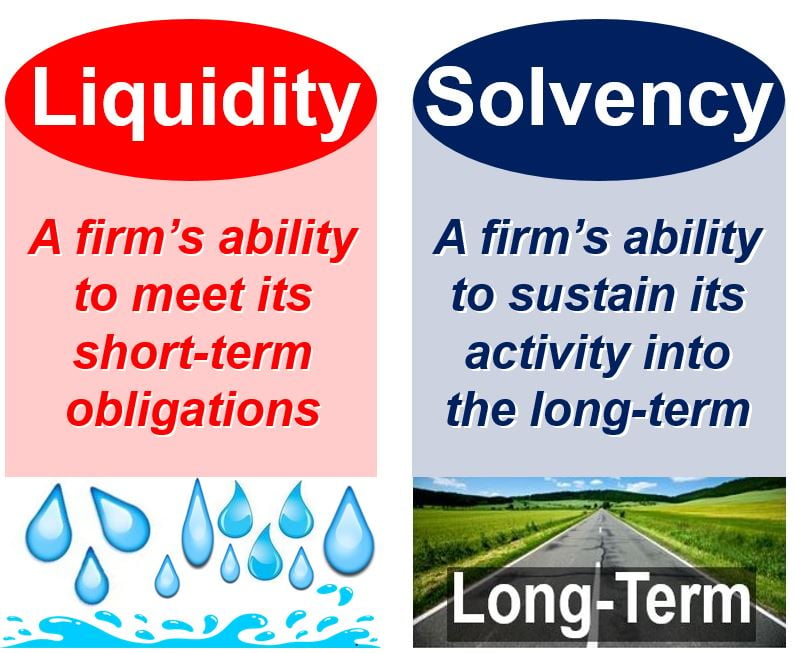In business and finance, solvency refers to a company’s or person’s ability to meet their long-term fixed expenses, i.e., pay their bills. A solvent company is one whose current assets exceed its current liabilities, the same applies to an individual or any entity. In other words, a solvent company owns more than it owes.
If a company is solvent it is able to accomplish long-term expansion and growth, as well as meeting its long-term financial obligations.
A solvent company is able to pay its obligations when they come due and can continue in business.

Some analysts look at a firm’s working capital when determining whether it is solvent, arguing that a positive amount of working capital is closely linked to degree of solvency. In other words, a solvent company should have a current ratio that is greater than 1:1.
Others look at a business’ total assets and total liabilities to determine whether it is solvent. If its total assets are greater than total liabilities, it must be solvent, they say.
According to accountingcoach.com, the definition of solvency probably varies from country to country and even among people in the same country. “You should check the legal system in your country to find the appropriate meaning,” it adds.
Solvency versus liquidity
Both solvency and liquidity refer to a company’s state of financial health, however, the two terms are different.

Liquidity refers to a company’s ability to pay short-term obligations, while solvency refers to its capacity to meet its long-term obligations. Liquidity also refers to a business’ ability to sell assets rapidly to raise cash.
A company may have high liquidity but not solvency, or high solvency but low liquidity. In order to function in the market place, both liquidity and solvency are important.
A highly solvent company with a liquidity problem – a cash problem – can usually get hold of cash by borrowing it. Banks are more inclined to lend to customers who are solvent.
A company can be insolvent but has liquidity. This occurs if it has enough cash to meet its current or near-term debts, however, all of its assets are worth less than the total amount of money owed.
A business can often resolve insolvency, especially if it has liquidity. To do so it must reduce expenses to increase cash flow so that it eventually has more assets than debts – or it can reduce debts by negotiating with creditors to reduce the total amount owed.
Solvency ratio and liquidity ratio
Solvency ratio and liquidity ratio can tell you how well a company can pay its long-term and short-term financial obligations respectively.
Solvency Ratio = Total Assets ÷ Total Liabilities
Total assets include all inventories. A larger number indicates greater solvency than a smaller number. For example, a company with a solvency ratio of 1.2 is solvent, while one whose ratio is 0.9 is technically insolvent. One with a ratio of 1.5 is more solvent than one with a ratio of 1.4.
A firm’s solvency ratio can affect its credit rating – the lower the ratio the worse its rating can become. A lower credit rating means it will be harder to borrow money.
Liquidity Ratio = Current Assets ÷ Current Liabilities
Current liabilities refers to money that must be paid within the next 12 months. Not all of the company’s basic inventory is included in current assets – only such assets as money owed to it by other firms and individuals plus marketable securities.
Video – What is Solvency?
Etymology (origin) of the term ‘Solvency’
The term SOLVENCY originates from the Latin word SOVENTIA, meaning “ability to pay.” This Latin term is composed of SOLVĒRE, which means “to loosen, to dissolve, or to pay,” and the suffix -ENTIA, indicating a state or condition.
Historically, solvency referred to the ability of a person or entity to meet financial obligations or, more broadly, to maintain a state of financial health by having assets exceed liabilities.
The term entered the English language in the late 16th century.
Quotes using the term ‘solvency’ or ‘solvent’
“Markets can remain irrational longer than you can remain solvent,” (John Maynard Keynes, 1883-1946 – a British economist whose ideas – Keynesian economics -had a major impact on modern economic and political theory and on many governments’ fiscal policies)
“To investors, job creation is a second-order effect. Market participants care first about interest rates, exchange rates, bond prices and the one great factor that affects all three: the long-term solvency of a bond company called the U.S. government,” (Amity Shlaes – an American and newspaper and magazine columnist who writes about politics and economics)
“Personal savings accounts to me are one of the most powerful things, not necessarily in saving, solvency, or bankruptcy of the program, but in guaranteeing, the words I used a few minutes ago, a safe and secure retirement for our seniors,” (Bill Frist – an American physician who became a Republican Senator representing Tennessee, serving as Majority Leader from 2003 to 2007)
“The purpose is clear. It is safety with solvency. The country is entitled to both” (Dwight D. Eisenhower, 1890-1969 – 34th President of the United States)
